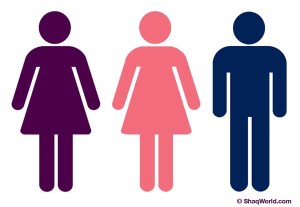Is bisexuality more common among women or men?
I honestly don’t know, but I recently answered some questions for Maria Elena Barnabi at Cosmopolitan Italy. Maria Elena wondered about the following “trends” re bisexuality and women musicians, and the following responses are how I mused them out. What do you think?
—
MEB: Is it true that bisexuality is more common amongst women then men?
DrCT: Gender is very complex and sexualities are very complex, as is our comprehension of intersections occurring between them, which are shaped by everything from biology to age to psychology to social norms/pressures and more. Given that, bisexuality seems to be more prevalent in women – it’s more visible, discussed more frequently, and appears to be more accepted. This does not mean it necessarily is more common though.
MEB: Do we have any numbers about it?
DrCT: As far as I know, no – only estimates, which can themselves be illustrative and revealing. As far as I know, there are no concrete statistics describing the actual prevalence of any various sexual identities as they vary by gender. Such data would be nearly impossible to gather…
MEB: If so, what is the explanation of that?
DrCT: It’s impossible to accurately gather a data point about every person’s sexuality (or even a representative sample thereof), especially when one’s conceptualization of sexuality can vary so significantly across demographics. What’s bisexual to one is heteroflexible to another and so on. And as Kinsey demonstrated so long ago, people conceptualize their sexuality identities on multiple, intersecting fronts. Though descriptors exist, they are estimates at best, especially in today’s evolving social climates.
MEB: In my opinion, female artists are more free to say that they are bi because this adds sex appeal to them, as men thinks that bi women are hot. While if a straight man would say that he is also into men, then automatically he would considered less sexy. Do you agree with these statement? What do you think about it?
DrCT: Women in general seem to have more “play” with their gender and sexuality expression relative to men. Though gender and sexuality normativity have controlled and confined women and men of all orientations and classes in variable ways since the dawn of time, women seem to have chipped away at these confines further than men have. This goes for women of all gender and sexuality expressions, though some have “progressed” (chipped away at the social confines) more than others.
There are a number of factors that could’ve contributed to this – social class, for example. More money, resources, and power may lead to more freedom in some instances of expression. There’s also the issue of sexualization and the proverbial “male gaze” – in some instances, the performance of heteroflexibilty in women many actually be about heteronormativity. And there have even been suggestions of a sort of “evolutionary biology” perspective, wherein the absence of men for whatever reason evolved into the possibility of women with women partners. So given all this, the “sexiness” factor related to heteronormativity may be a factor in some way.
In terms of men, the lack of apparent bisexuality plays into the same heteronormative masculinity ideals. Even for men who identify as gay, there’s a social pressure to be either/or – one way or the other, with a fixed sexuality expression. Men seem to have less “play,” especially when it comes to sexuality as it ties to gender.
—
Maria Elena’s questions were really thought-provoking… even thinking about answers to her questions on a superficial level is very complex! From individual psychology, social class, and our ever-evolving social climate, there’s a lot going on.
* * *
Got a sociology question? Need some social justice informed life advice? Contact Dr. Chauntelle right here.
Get Exposure: A Sociologist Explores Sex, Society, and Adult Entertainment on Amazon and CT.com
